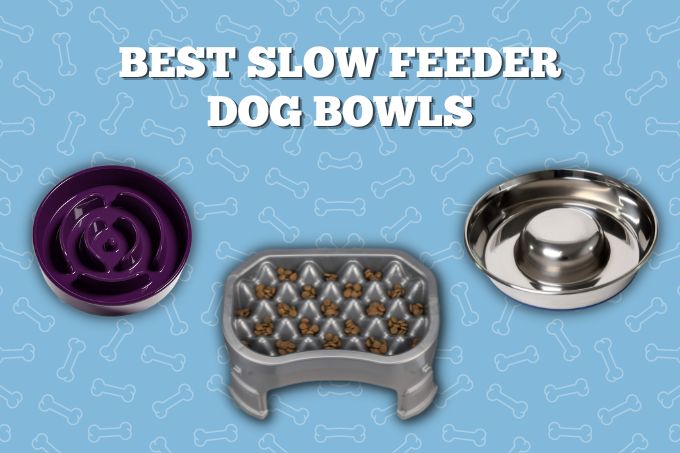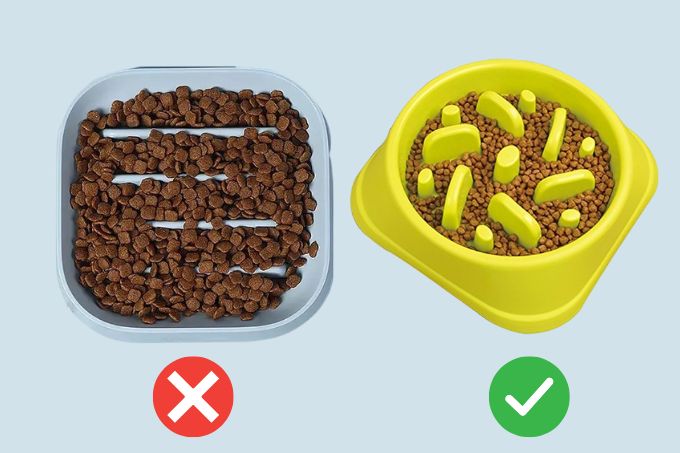This post may contain affiliate links, which means we may receive a commission from purchases made through these links. See our affiliate disclaimer.

Dogs that get overly excited at mealtimes tend to scarf their food down, which is really cute to watch but poses certain risks for them. There’s nothing we can do about that excitement, but we can slow down the pace of their eating, and using slow feeder dog bowls is an effective way of doing that.
In this Best Of list, we explain which dogs may benefit from slow feeder dog bowls, what to look for when picking a bowl, and present our top 8 picks with pros & cons for each bowl.
Our picks at a glance
Why use a slow feeder dog bowl?
Dogs that chow their food down too quickly are at risk for certain stomach issues: vomiting, gassiness, and bloat to name a few. While some of these issues are merely unpleasant (have you ever smelled a gassy dog’s farts?!), others can be dangerous.
Often there are can also certain behavioral issues that need to be corrected. Dogs that eat too fast may do so as a survival instinct — they’re worried their food will be taken away if they don’t finish it as quickly as they can. Perhaps they’ve experienced their food being stolen by their sibling as they were puppies, or even another dog in the household.
Using a slow feeder dog bowl also has mental health benefits. Dogs that are smart get bored and they appreciate a challenge, which can come in the form of a maze they have to navigate to get to their food.
Which dogs will benefit from slow feeder dog bowls?
Best overall slow feeder dog bowl
Our pick for best overall slow feeder dog bowl is the Outward Hound fun feeder slo bowl in turquoise. It’s a very popular bowl (over 111,000 ratings!), and with good reason.
This bowl is quite effective in slowing down fast eaters, the design & depth of the ridges just work for some reason. The base is sturdy and mostly able to prevent slipping, which is a big factor in dogs’ comfort while eating.
It’s made of food-grade, high-quality plastic, but it is still plastic and therefore prone to chipping and cracking over time. This bowl comes in a few attractive colors, each of them with a different design of ridges & patterns.
Best budget
The UPSKY dog bowl is one of the cheapest slow feeders we could find. If you want to give slow feeders a trial run, or if you want one to use as a spare/for travel, this may be the one for you.
The tiny rubber grips on the bottom aren’t very sturdy at all, but put it on a feeding mat and you’ll be good to go. This only comes in one size (8-inch diameter), which may not be a good fit for extra small or extra large dog breeds.
Best stainless steel
Stainless steel slow feeders are slowly gaining popularity. They’re more hygienic, easier to clean, and more durable than plastic bowls. However, there aren’t too many stainless steel options available yet.
PEGGY11’s is our pick because the metal is sturdy and of high quality. The rubber base, while only covering the rim of the bow, does the trick — this bowl doesn’t slide around too much. We recommend the large-sized variant for most dogs, and the medium-sized variant for small dogs & puppies.
Best ceramic
Le Tauci’s ceramic slow feeder bowl is just beautiful. This is the bowl for fur parents that want the aesthetic to match their homes. Comes in 3 sizes and 5 attractive colors.
Ceramic bowls are easier to clean and therefore more hygienic, but must be handled with extra care at all times. Drop them once and they’ll need to be replaced.
Best elevated slow feeder dog bowl
A slow feeding bowl that’s elevated (3 inches), with the option to adjust the height further to 7.5 inches with the included “legs”. Comes in 2 size variants (2.5-cup and 6-cup), so it works for big or small dogs. The plastic is sturdy and the feeder is well-made. You get a lot of value for the price paid.
This is a big feeder, and it will take up some space in your dishwasher. The rubber grip works, but still slips some against large dogs.
Best for flat-faced dogs
The LeashBoss feeder was designed specifically with flat-faced dogs in mind, which is nice. It works exactly as intended; however, there’s one size only (1.5-cup capacity), which means refills will be required for larger dogs.
The rubber grip needs improvement, but that’s nothing a feeding mat can’t fix.
The Neater slow feeder is our runner-up pick for flat-faced dogs. Check out our review of it above.
Best for small dogs
Dogit’s slow feeder bowl is the only one we reviewed that had an extra small size variant. It’s a sturdy bowl, it’s non-slip and it works as intended. The simple maze design on the bowl isn’t too challenging, which may be a good thing or not, depending on your dog’s personality. Read more on that below, in our guide for picking a slow feeder bowl.
We picked this bowl specifically for extra small breeds and puppies only, as there are many other bowls that work as well or better, just not in the appropriate size.
Best for large dogs
The second stainless steel slow feeder on our list, we were happy to find the Durapet slow feeder offered in this large capacity. There are 3 size variants, the largest one being a whopping 6-cup capacity, 11-inch bowl. We recommend the medium-sized one (4.5 cups, 9 inches) for most large dogs.
The single, large ridge in the center will work well for large dogs with big snouts — slowing down their chowing without making it impossible to eat. Considering the size and quality of this bowl, it’s a rather inexpensive one.
What to look for in a slow feeder dog bowl
Not all slow feeder dog bowls are created the same, so you’ll want to find one that works for your dog. Often that’s down to the design of the bowl, but may also depend on your dog’s personality or anatomy. We go into further detail below.
Capacity

The capacity of the bowl may play a big role in slowing down your dog’s eating pace. A bowl that’s too small won’t work; the food will be easily accessible because it’s around and over the ridges.
You’ll want to go up a size or two. The kibble should be below the level of the ridges to effectively slow your dog down.
Design
Some slow feeder bowls are more difficult to eat from than others. The design of the ridges, the pattern it creates and the depth of the bowl — all of these things are purposeful and make the bowl easier or harder to eat from.
Some dogs will respond better to bowls with an easy pattern: dogs that easily get frustrated & give up, or dogs with big snouts that can’t navigate smaller spaces, for example. Other dogs need the challenge of a complex pattern to slow them down, with the additional benefit of their mealtimes becoming mentally stimulating for them.
Flat-faced dogs need a bowl with shallow ridges. Their snouts don’t protrude enough to navigate deep spaces and the wrong slow feeder will be unnecessarily challenging for these dogs. See our pick for flat-faced dogs above.
The rubber grip on a slow feeder is an important feature. These bowls are meant for dogs to poke around in and lick to get to hard-to-reach places. You’ll want a bowl with a sturdy rubber grip that will keep it in place — the maze pattern is enough of a challenge and bowl slippage will just be downright frustrating.
Material
Most of the slow feeder dog bowls in the market today are made of plastic, which is reflected in our list above. However, there are slow feeders made of stainless steel or ceramic, too.
Stainless steel bowls are the most durable and most hygienic. They’re easy to clean and don’t harbor bacterial growths on their smooth surfaces. However, the maze pattern on stainless steel bowls are often much simpler than their plastic counterparts.
Ceramic bowls are beautiful. They come in pretty designs and complex patterns that just look aesthetic. However, ceramic is brittle and chips pretty easily — they’ll have to be tossed as soon there’s any sign of chipping, and these bowls aren’t cheap.
Plastic bowls comes in all sorts & forms, and are often the cheapest option. If you pick a plastic bowl, make sure it’s free of BPA and other harmful chemicals, as all the plastic options in our list above are. Plastic bowls do tend to harbor gunk more than other bowls, so some rinsing by hand might be needed before putting it in the dishwasher.
Now that you have a much better idea about slow feeder bowls, why not check out our guide to some other types of bowls?

















